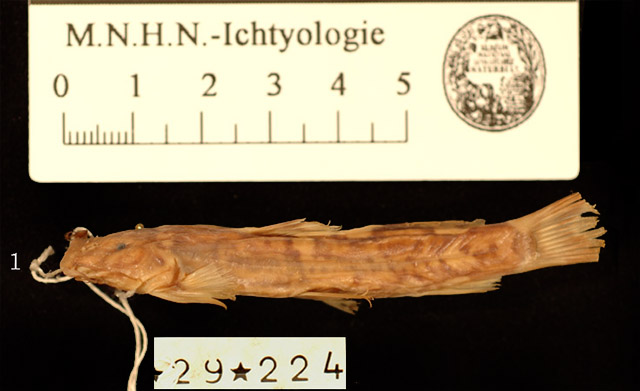|
Dorsal spines (total): -0; Dorsal soft rays (total): 7; Anal spines: -0. Diagnosis: adipose fin large, its origin close to dorsal fin; pigmentation not in a banded pattern, colour pattern striking with varied dark brown patches and spots with clear white interspaces, caudal fin clear with narrow black bands; eyes widely spaced (interorbital width 2.3-3.7 times orbit diameter); origin of dorsal base less than head length behind head; dorsal base before origin of pelvic fins; dorsal fin rectangular with leading (simple) ray shorter than length of leading edge; caudal fin with 6+7 principal rays; caudal peduncle compressed, short, 5.7-6.4 times in SL, slightly longer than deep (length 1.3-1.5 times depth); snout long, half of head length; eyes placed equidistant from hind margin of head and tip of snout (mid-way along head)(Ref. 81646).
Description: body moderately broad and deep anteriorly, tapering evenly to a compressed caudal peduncle; head short, 3.75-4.4 times in SL, and depressed, transverse profile gently rounded above and flat below; branchiostegal membrane deeply cleft mid-ventrally; mouth broad; lips thick and fleshy; jaw teeth caniniform in bands; barbels subequal to head length; nostrils in mid-snout, narrowly separated; eyes dorsal, small, widely spaced, confluent with head (no free orbital margins); fins well-developed; dorsal fin with 1 unbranched and 6 branched rays; pectorals with 1 unbranched ray and 8-9 branched rays, truncate posteriorly, fan-like with slender pectinate and padded lead ray and inner rays aligned vertically along body, not reaching base of pelvics; pelvics with 1 unbranched and 5 branched rays, truncated posteriorly not reaching base of anal, with slender padded and pectinate lead ray; anal fin with 1-3 unbranched and 4-6 branched rays, short based, not reaching caudal base, with 1-3 unbranched rays and 4-6 branched rays; caudal deeply emarginated to shallow forked, with crenellate fleshy pad over base; adipose fin large, shallow and gently arched, base extending from behind dorsal fin to behind anal base, close to caudal fin origin (Ref. 81646).
Coloration: varies between individuals; characteristically with a striking pattern of contrasting dark brown patches and irregular marbled markings against cream or light brown spaces with 3-4 clear dark-edged saddles behind head, dorsal fin, and anteriorly and posteriorly on adipose fin; fins clear or lightly pigmented, caudal fin with varied dark spots forming a mid-band; ventral surfaces cream or very light brown (Ref. 81646). |

